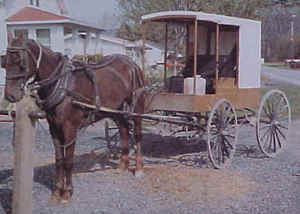The Nebraska Amish
The Nebraska Amish find themselves on the ultraconservative edge of Amish society.
‘Nebraska’ is something of a misnomer, however. This group is found mainly in Mifflin County, PA, in the diverse ‘Big Valley’ region. A second, smaller group is found in northeastern Ohio.
The Nebraska tag comes from the origin of the group’s founding bishop, Yost H. Yoder. Today there are a number of subgroups within the Nebraska Amish affiliation.
John Hostetler’s Amish Society describes some defining cultural characteristics for the Nebraska group.
Men wear ‘William Penn’-style shoulder-length hair, no suspenders or belts, and brown denim pants and vests.
Women wear black head kerchiefs (bonnets are taboo), flat Alsatian-peasant-inspired hats for field work, and the longest dresses of all Amishwomen.
Lawnmowers, window screens, carpets and curtains are off limits.
Hostetler explains that Nebraska barns go unpainted, as do most of the homes.
An old world practice followed by the Nebraskans, also known as the ‘Old School’ Amish, is the funeral custom of sweet bread, wine, and cheese.
Finally, the most easily visible defining characteristic of the group is the transportation. The Nebraska Amish drive the conspicuous white-top buggies, a perennial favorite of photographers of the Amish.





i had an idea a while back, but do not know how to submit it to the amish society…
a time back, while visiting delaware, i had a discussion in which a man was commenting on the “lameness” of many of their horses…
the reality of the enduring existence of asphalt roads cannot be contested…at first, i thought that shoes fashioned out of recycled tires would be a solution, but that might create an unwanted “class” disturbance where only some families had “street” horses….
i have now amended the proposal for rubber “socks”…footings designed to reduce the stress of walking and trotting on hard surfaces…easily put on and taking off…extending the usefullness of a workhorse, and improving its quality of life…perhaps even just a thin tread for their wheels, but i don’t know if i’m reaching too far…
perhaps you have a way of proposing the idea…
anthony lotrich
Amish horse and buggy innovations
Hi Anthony, horse socks sound pretty comfy! I am not a horse person so can’t comment on feasibility but on the Amish as a general rule innovations enter slowly, though they are not against new things that can improve their or their animals’ well-being, provided that they do not introduce potentially destructive elements (ie, TV, car ownership).
As for lining buggy wheels, Amish churches usually have fairly entrenched regulations as to what is allowed. Adding rubber to buggy or tractor wheels has generally been seen as a step in the direction of the car so that has been a traditional stopping point for many churches.
As to sharing the idea the best way would be to float the idea directly–I honestly have no idea what response you might get. The Amish in Delaware may be approachable (the “Nebraska” group, less likely).
Question about window screens.
My question is, respectfully, why aren’t window screens allowed?
Why don't some Amish use window screens?
Hi Sarah, thanks for the question, there’s a long answer, but the short and sweet would be that it’s a combination of tradition, a general avoidance of worldly trappings, and a reluctance to change. Some of the items that Amish prohibit might not “make sense” to the rest of us, but they may be doing so in order to mark themselves as different from another, more progressive group, for instance. The more conservative groups are generally just very slow to change, and are reluctant to take on even seemingly inconsequential changes. They value plainness, and not having window screens is one way that is manifested. Many Amish do use window screens, however.
more screens
Thank you, Erik. Part of the reason I asked was because I have actually seen Amish-made screen doors (quite lovely in their craftmanship) and I guess I was just puzzled how one could make something that one can’t use…but the differing groups makes sense…
Window screens "worldly?"!
Difficult to imagine anything plainer, in the usual sense of the word, than a window screen! I’d love to see the long answer, if you haven’t already written it somewhere? And, indeed, what was their objection to the bonnet?
As a Christian philosophy graduate, I’m intrigued by how various different church groups work things out, and what conclusions they come to. I find the Amish particularly interesting because they have (in general) a cultural integrity of regarding belief as only meaning something if it is played out in action, which is not as common among Christian groups as perhaps might be expected.
I appreciate the thing about, “The church down the road adopted window screens, and then also adopted [insert other thing here which we don’t think is a grey area],” because that’s a sort of universal congregational dynamic (my church’s version of it would be something like, “First you put candles on the altar, next you’re denying Both Kinds to the laity”). And caution about change also makes a fair amount of sense. But I’d really love to know the logic behind the notion that a window screen is a “worldly trapping”. It would seem to me that it was a plain utility item like a buggy cover or a rubber tablecloth. (Of course, I do realise that one option is that in the time and place concerned, it isn’t a simple utility item: if keeping up with the Jones by having the most gaudily decorated fly-screen was commonplace locally, then it’s possible to see the objection – but you have to know that’s what’s going on to make sense of it).
Reply to Anthony Lotrich
It is the pounding of the hooves on the hard pavement that is behind a lot of the lameness. The lameness is in the legs and joints, not in the hooves. Spavin, navicular, ring bone, bowed tendon, arthritis, crossover bruising, the list goes on. A lot of the horses are slower speed race horses that are good used. Their already broke to harness, bought inexpensively at auction, used up then resold at auction. If they are lame their destined for the can. It is a win win for everybody but the horse.
The Amish don’t have to carry the expense of raising a foal to driving age and the time it takes. The auctioneer sells the same horse twice and the animal food maker gets cheap raw material. All very efficient, cold but practical. Farmers don’t have retirement programs for livestock. They won’t be needing shoes.